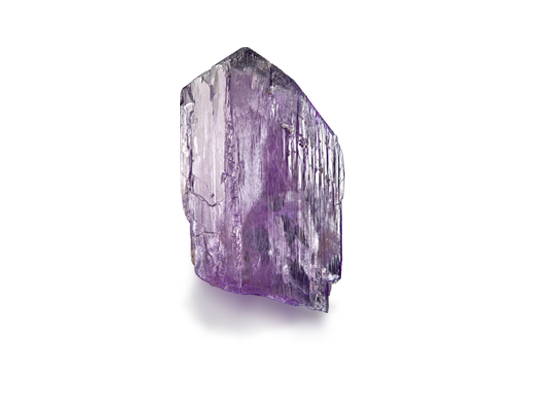OVERVIEW
unzite is the best-known variety of the mineral spodumene. It’s named after famed gemologist George Frederick Kunz, who was the first to identify it as a unique variety of spodumene. Kunzite gets its delicate color from trace amounts of manganese. California’s San Diego County is an important source of kunzite.
Kunzite is the light pink to violetish purple variety of the mineral spodumene. It’s found in Afghanistan, Brazil, Madagascar, and the US state of California. The gem was named after pioneering gemologist George Frederick Kunz (1856-1932).
Kunzite has two perfect cleavage directions. It’s pleochroic, with the best color visible when you look down the length of the crystal. Cutters keep these factors in mind when they orient gems for finishing. They might also cut a kunzite deep to emphasize its pink to violet color.
It is not unusual to find kunzite in large sizes. The Smithsonian Institution houses a faceted heart-shaped kunzite that weighs 880 carats.
Kunzite can be irradiated and then heat-treated to enhance its color. Both treated and natural color in kunzite can fade with exposure to heat and bright light.
- Mineral: Spodumene
- Chemical composition: LiAlSi2O6
- Color: Pink-violetish purple, light-intense
- Refractive index: 1.660 to 1.676
- Birefringence: 0.014 to 0.016
- Specific gravity: 3.18
- Mohs hardness: 6.5 to 7.0
BIRTHSTONE
Some consider kunzite to be an alternate birthstone for February.
HISTORY
Kunzite is a relative newcomer to the array of colored stones available for use in jewelry. As the story goes, specimens of an as-yet-unidentified pink crystal were found in San Diego County, California, and sent to Tiffany & Co.’s mineralogist, George Frederick Kunz. The year was 1902. Kunz was able to confirm that the crystals were, in fact, spodumene, but the previously unrecognized color made the find a new variety of the mineral.
Charles Baskerville, a chemistry professor at the University of North Carolina and later the City College of New York, subsequently named kunzite in honor of George Kunz in 1903.
In the years since, kunzite has proven to be a highly desirable gem. Occurring in attractive shades of pink to violet, kunzite crystals are also often large, with relatively few inclusions. Though difficult to cut due to its two cleavage directions, it lends itself to lovely finished gems that show magnificently in fine jewelry.
Source of Content : www.gia.edu


